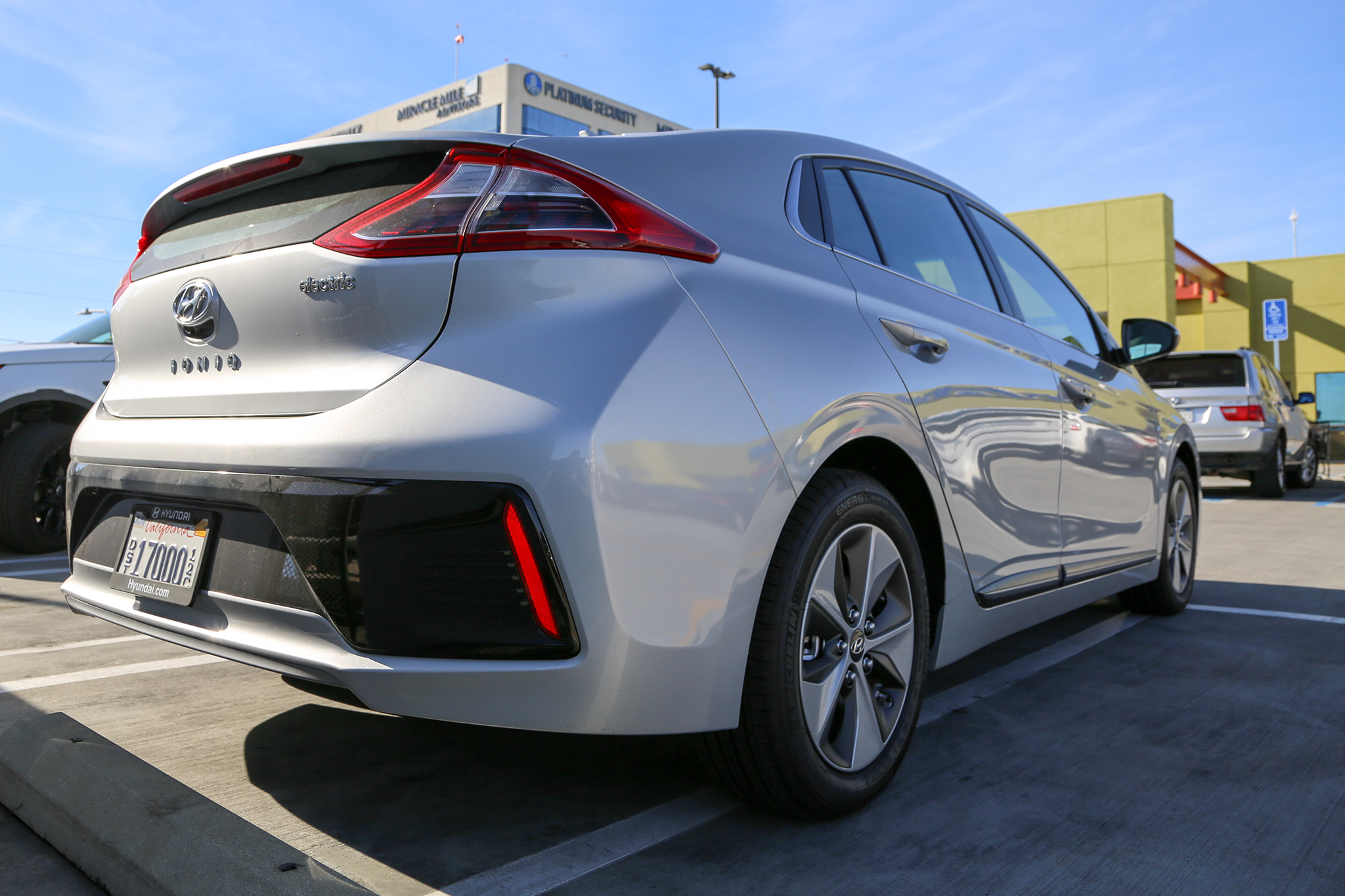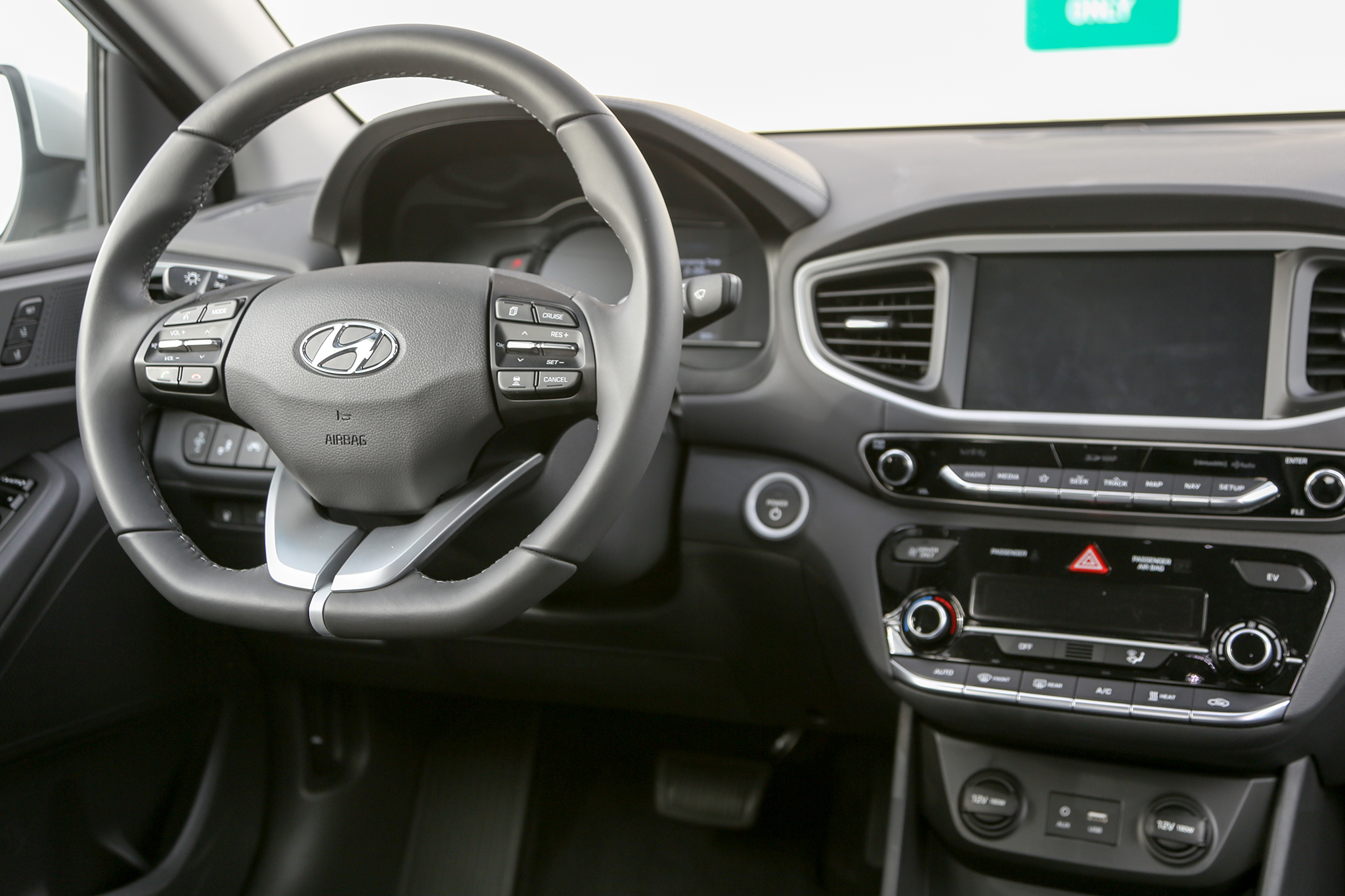There’s an elegance in simplicity and luxury in refined minimalism. The Hyundai Ioniq Electric Limited may at first seem like an exercise in Marie Kondo–style automaking, but after spending several days with Hyundai’s compact EV, I found joy in a well-executed electric runabout.
The Ioniq looks and functions very much like a normal and only slightly futuristic car. It’s nicely packaged beneath the slippery aerodynamic bodywork, with the electric motor situated in the engine bay like a typical gas-powered car and the battery pack stretching from under the rear seats to under the floor of the trunk. Despite this positioning, there’s still plenty of stowage space. I packed a generous load of groceries in the hatchback’s cargo area and still had room to spare for five medium-size picture frames.
The Ioniq is nice to drive too, with the electric motor’s 218 lb-ft of torque providing ample acceleration off the line. The torque is managed well by the traction control and power-delivery software, and I only coaxed a faint chirp from the skinny tires a handful of times during full-throttle runs. The only time I truly wanted more from the powertrain was on the highway, since the motor’s 118 horsepower is just enough to allow you to squeak by when making passes, but not much more.


Like other electric cars on the market, the Ioniq features several tiers of regenerative braking, with the medium setting serving as the default. Steering-wheel-mounted paddles adjust the regen intensity, but I found myself using the most forceful option during the majority of my driving. This one is calibrated to deliver the most forceful deceleration—it slows the Ioniq about as quickly as a normal driver would typically come to a stop—so you only need to use the brake pedal to achieve a complete stop. I would prefer true one-pedal driving, though, as offered in some other EVs.
Speaking of other EVs, battery capacity is where the Ioniq looks weakest against its competition. The 28-kWh pack only delivers an EPA-estimated 124 miles; among similarly priced competition, the new Leaf Plus has 226, the Chevy Bolt 238, the Kia Niro EV 239, and the Kia Kona Electric 258. Despite the low range, the onboard computer approximates the remaining mileage more accurately than I’ve experienced in other EVs, which was front of mind as the pricier and larger Jaguar I-Pace I drove the previous weekend tended to be overconfident about how much farther I could travel. The tiny battery can be topped off relatively quickly, at least, especially with a Level 3 charger.
The Ioniq was designed to offer three powertrains—gas/electric hybrid, gas/electric plug-in hybrid, and this full-electric one—which beyond the range issue is most noticeable in that the charging port is in the same place as the normal fuel-filler cap. That means it’s better to back the car into parking spots for charging. This isn’t always a problem, but it can be a nuisance to drive past a stall in a crowded parking lot when there’s a whole line of traffic waiting to get through.
An inconveniently positioned charging port couldn’t derail an overall positive experience with the Ioniq, though. As someone who’s a total sucker for a well-laid out cockpit, I was a huge fan of the interior design. Like other cars in the Hyundai family, the layout of buttons is very intuitive and the quantity of controls doesn’t overwhelm.
The absence of many of the pieces required for internal combustion also leaves a large storage spot below the infotainment cluster, with enough space for a medium-sized bag. Near the two cupholders between the driver and passenger is a spot for wireless device charging. It’s sloped, padded, and even contains a little nub inside to keep your phone from moving under braking. Materials in the cabin are upscale for the segment as well, from the inclusion of a standard leather-wrapped steering wheel on this Limited example to the soft wrist pad for the gear selector.


The Limited stickers for $37,200 before factoring in the $7,500 EV tax credit, bringing the final price to a reasonable $29,700. Unfortunately, the Ioniq Electric misses out on some features that are now common in the $30K ballpark. (For what it’s worth, you can also get a version of the Electric with fewer features for $31,325 before incentives.) The absence of dual-climate control, ventilated seats, and parking sensors are the larger omissions I noticed during my weekend behind the wheel.
This being said, the Ioniq does have plenty of equipment. At the Limited trim level, there’s standard Android Auto, Apple CarPlay, heated seats, and adaptive cruise control. It all feels very premium, especially because the sound deadening and suspension keep the noise in the greenhouse to a minimum, key when there’s no engine thrum to drown out ancillary sounds.
Hyundai has said that the Ioniq Electric will get even more range with subsequent updates, and I’d be eager to drive one with the equipment as the Kona Electric, which has a 201-hp motor and 64-kWh lithium-ion battery pack. EV shoppers will likely have to hang on until 2020 for the updated model to appear at dealerships.
Even though the Ioniq can’t compete with the range of other EVs on the market, it succeeds with its clever packaging, practicality, and pleasant driving manners. For those without a need to travel far afield and who are looking for an around-town EV, the Ioniq Electric is a solid choice.
2019 Hyundai Ioniq Electric Specifications |
|
| ON SALE | Now |
| PRICE | $31,235/$37,200 (base/as tested) |
| MOTOR | Permanent-magnet synchronous AC, 118 hp, 218 lb-ft |
| BATTERY | 28-kWh lithium-ion |
| TRANSMISSION | 1-speed direct drive |
| LAYOUT | 4-door, 5-passenger, front-motor, FWD hatchback |
| EPA MILEAGE | 150/122 MPGe (city/hwy) |
| EPA MAX RANGE | 124 miles |
| 240V CHARGE TIME | 4 hours (est) |
| L x W x H | 176.0 x 71.7 x 57.1 in |
| WHEELBASE | 106.3 in |
| WEIGHT | 3265 lb |
| 0–60 MPH | N/A |
| TOP SPEED | N/A |
